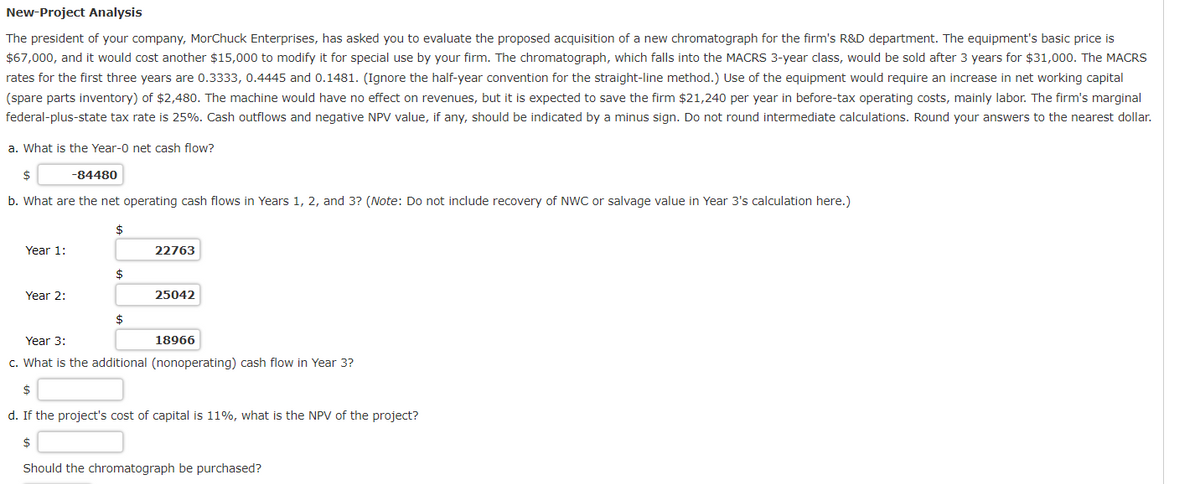New-Project Analysis The president of your company, MorChuck Enterprises, has asked you to evaluate the proposed acquisition of a new chromatograph for the firm's R&D department. The equipment's basic price is $67,000, and it would cost another $15,000 to modify it for special use by your firm. The chromatograph, which falls into the MACRS 3-year class, would be sold after 3 years for $31,000. The MACRS rates for the first three years are 0.3333, 0.4445 and 0.1481. (Ignore the half-year convention for the straight-line method.) Use of the equipment would require an increase in net working capital (spare parts inventory) of $2,480. The machine would have no effect on revenues, but it is expected to save the firm $21,240 per year in before-tax operating costs, mainly labor. The firm's marginal federal-plus-state tax rate is 25%. Cash outflows and negative NPV value, if any, should be indicated by a minus sign. Do not round intermediate calculations. Round your answers to the nearest dollar. a. What is the Year-O net cash flow? -84480 b. What are the net operating cash flows in Years 1, 2, and 3? (Note: Do not include recovery of NWC or salvage value in Year 3's calculation here.) $ Year 1: Year 2: Year 3: $ 22763 25042 18966
Net Present Value
Net present value is the most important concept of finance. It is used to evaluate the investment and financing decisions that involve cash flows occurring over multiple periods. The difference between the present value of cash inflow and cash outflow is termed as net present value (NPV). It is used for capital budgeting and investment planning. It is also used to compare similar investment alternatives.
Investment Decision
The term investment refers to allocating money with the intention of getting positive returns in the future period. For example, an asset would be acquired with the motive of generating income by selling the asset when there is a price increase.
Factors That Complicate Capital Investment Analysis
Capital investment analysis is a way of the budgeting process that companies and the government use to evaluate the profitability of the investment that has been done for the long term. This can include the evaluation of fixed assets such as machinery, equipment, etc.
Capital Budgeting
Capital budgeting is a decision-making process whereby long-term investments is evaluated and selected based on whether such investment is worth pursuing in future or not. It plays an important role in financial decision-making as it impacts the profitability of the business in the long term. The benefits of capital budgeting may be in the form of increased revenue or reduction in cost. The capital budgeting decisions include replacing or rebuilding of the fixed assets, addition of an asset. These long-term investment decisions involve a large number of funds and are irreversible because the market for the second-hand asset may be difficult to find and will have an effect over long-time spam. A right decision can yield favorable returns on the other hand a wrong decision may have an effect on the sustainability of the firm. Capital budgeting helps businesses to understand risks that are involved in undertaking capital investment. It also enables them to choose the option which generates the best return by applying the various capital budgeting techniques.
Finance

Trending now
This is a popular solution!
Step by step
Solved in 3 steps with 2 images









